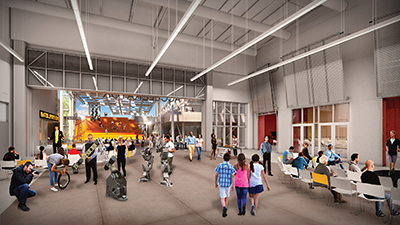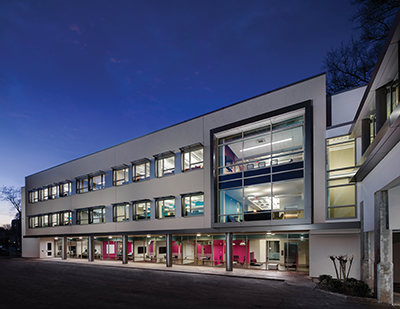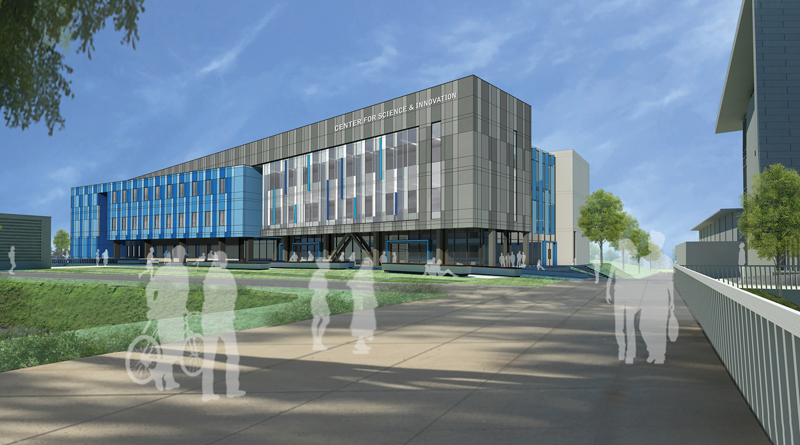Design in Dialogue
By Daedalus Howell
For this year’s architect roundtable, School Construction News spoke with three women who are leaders in the industry: Pam Loeffelman, K-12 education leader at DLR Group; Lisa Fay Matthiessen, national sustainable design director at HGA Architects and Engineers; and Tracy Carusi, principal at Collins Cooper Carusi Architects. Each offered cogent answers to questions we hoped would spark a spirited discussion about design and its place in the experience of those who both shape it and encounter it in real life.
Q: Baking sustainability into design for education seems to be par for the course these days — or is it? How does this mindset inform aesthetic decisions in design? Is there such a thing as “green fatigue?”

Photo Credit: DLR Group
Loeffelman: The definition of sustainability and green design is evolving. The USGBC and LEED initiated a culture shift in architecture and engineering that recognized the importance of designs that embrace stewardship of our earth’s natural resources. Additional organizations and their resulting “check lists” continue to prescribe how a client can best celebrate a return on investment in a design that is functional, aesthetically pleasing and sustainable.
However, most clients have their own metrics of success. These metrics have continued to evolve the definition of sustainability. Certainly the operating/life cycle costs of buildings need to be considered; the use of building materials and systems that contribute to the quality of building environments related to air quality, health and wellness; and a return to good design policy regarding siting, orientation, massing and thermal envelope all contribute to high-performance buildings that represent not only good design, but also a fiduciary responsibility to clients and the funds invested in any building outcome.
Matthiessen: Sustainability is not par for the course in design for education, not in the full sense of the word. Much or most of the market is aware of and using metrics to measure sustainability — usually LEED. The use of LEED has indeed made sustainability a topic or priority for many clients and designers, but sustainability is not a finite topic. It’s not something that you learn how to do and then you are done. We have reached a level of awareness and competence around sustainability, and now there are many more levels to explore and boundaries to push. With LEED Silver being the norm now, we see schools reaching for net-zero energy. Other emerging priorities include water use, designing for human health and social equity. So yes, sustainability is a familiar topic now, but the more we know, the more we have to explore.
Carusi: There is no doubt that sustainable design is more of a standard than an outlier in our client markets. However, our clients’ appetites for official certification has decreased over recent years, instead expressing a desire to be sustainable without formal certification. “Baking in” sustainability can impact our aesthetic decisions. For example, we know we need to avoid large expanses of west-facing glass in our designs at the outset or find a way to effectively shade the glass. This strategy certainly has a major impact on aesthetics. On the other hand, clients’ expectations that sustainable design has a certain sustainable look is not particularly valid. We completed a LEED Platinum project recently, the headquarters for Global Ministries in Atlanta, where the sustainability was “under cover” and not particularly identifiable from the exterior. This was not intentional, but merely the result of using fairly conventional design and construction approaches in ways where we still achieved a high sustainable goal.
Q: What issues or value propositions are architects and designers facing or pursuing in terms of expressing gender and identity politics through their work?
Loeffelman: All architects should take the responsibility to understand their clients and what architectural outcomes best represents their metrics for success. As clients represent various constituencies, it is important to focus on a building’s purpose and how to create environments that enable all constituencies to succeed. If one focuses too directly on gender and identity politics, there is a possibility of serving none rather than serving specific groups.
Matthiessen: To my mind, addressing issues of gender and identity must include internal reflection on the part of the design team. We must understand how these issues impact and shape our own processes and perspectives, and work to mitigate our shortcomings, before attempting to address these issues in our work. If the design team is homogeneous, then it needs to change. That said, I think it is absolutely true that gender and identity can inform design. For example, Frances Moore of SmithGroupJJR has done very compelling research into how women experience the world and has used this information to shape the design of a women’s hospital.

Photo Credit: Jim Roof
Carusi: I’m not sure that I would necessarily relate our particular clients’ issues to politics. Instead, they seem to be genuinely concerned about addressing their customers, members or student issues. In recreational facilities, we’ve been designing self-contained individual changing and shower rooms for years that are generally effective in addressing gender identity, among other matters such as age or religious preferences. Our university clients have occasionally asked us to include “unisex” individual toilet rooms in lieu of toilet batteries with multiple stalls.
Q: How do you account for obsolescence in your design? Nothing lasts forever, so how do you incorporated the “inevitable” in your design approach?
Loeffelman: Future-proofing buildings starts with the tenets of good design: appropriate understanding of community and context, building plans that provide a clear arrival sequence, circulation/wayfinding that is easily comprehended, and places and spaces that are well proportioned and flexible. While every building use evolves over time, creating buildings that are a “loose fit” for any activity allow for continual use and adaptation over time. This approach includes all building elements ranging from systems that are zoned to walls that are constructed from easily reconfigurable to permanent, or one-, five-, and 10-year walls.
Carusi: We have actually worked with a few repeat clients long enough that we have seen our original designs either demolished or repurposed. However, we work with many clients who expect to own their buildings for a minimum of 30 to 50 years and want us to design durable and timeless designs. It’s tempting to design with and explore the latest and greatest new material, trendy geometry or technology, and there is a place for that on the continuum of the overall design spectrum. However, taking that short view as an overall philosophy of practice generally does a disservice to our client and our communities.
Frequently, that “of the moment” approach is not human-centered, sustainable or durable. That said, one of the building types where planned obsolescence has been a recent factor is education. The need to continually reinvent and reconfigure in schools is more common today than ever. Public school systems who might have dictated CMU (concrete masonry unit) construction as a standard frequently accept our suggestion to use high-impact gypsum board construction with recycled content. You have the advantage of a high-recycled content with a more easily deconstructed system that allows economical reconfiguration and can continue to be recycled (steel studs and gypsum board). In addition, building structural components can be lightened using less CMU. Whether or not our clients are interested in building sustainably, our specifications require recycled content in most building materials, and we use more materials that can be easily recycled.
Neumann/ Smith Architecture have found that both economics and a trend away from unique interior finishes have recently allowed for more dynamic expressions of our clients’ branding and culture through the use of easily applied, removed and re-imagined environmental graphics. There is definitely a concept of planned obsolescence here.
To read the entire article, check out the March/April issue of School Construction News.

